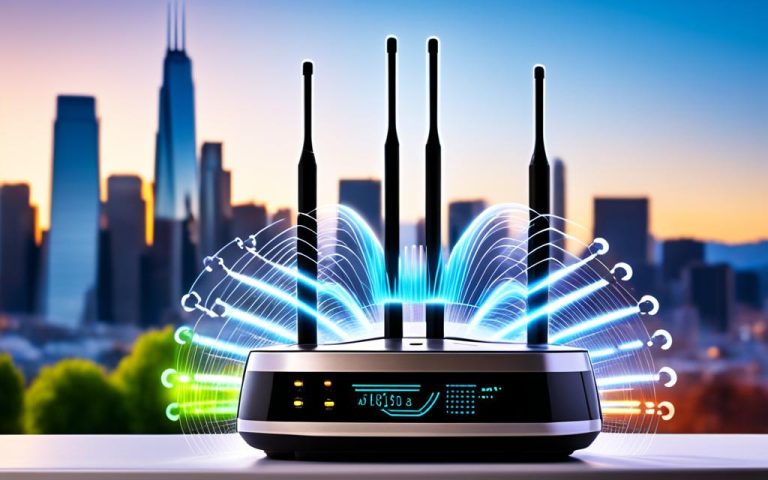Wireless security is of utmost importance in today’s digital age. Protecting your Wi-Fi network is crucial to safeguard your data, prevent unauthorized access, and mitigate potential threats. There are several Wi-Fi security standards to choose from, including WEP, WPA, WPA2, and the latest iteration, WPA3.
Let’s explore each of these standards and understand their strengths and weaknesses in ensuring a secure wireless network.
What is WEP?
WEP, or wired equivalent privacy, was the first attempt at wireless protection. It encrypts data transmitted over wireless networks using a static key. However, WEP has significant vulnerabilities, and its use is discouraged. It is still sometimes used due to outdated routers or devices that do not support newer encryption methods.
To understand the weaknesses of WEP, it’s essential to consider its encryption process. When data is transmitted over a WEP-secured network, the encryption key remains constant. This static key makes it easier for attackers to intercept and decipher the encrypted data. In fact, WEP’s encryption algorithm can be cracked within a matter of minutes using widely available hacking tools.
As a result, WEP is no longer considered a secure Wi-Fi security standard. Its vulnerabilities leave networks and connected devices susceptible to unauthorized access and various types of attacks, including data theft and unauthorized usage.
Although the use of WEP should be avoided, it is still sometimes encountered in older network setups or devices that have not been updated to support newer encryption methods. However, it is crucial to understand that relying solely on WEP for wireless security puts your data at significant risk. It is highly recommended to transition to more secure wireless security standards, such as WPA2 or WPA3, to ensure the protection of your network and sensitive information.
It’s important to note that WEP should not be confused with a Wireless Distribution System (WDS), which provides a way to extend the range of a wireless network but does not provide any additional encryption or security measures. Implementing WDS in conjunction with WEP does not address the fundamental vulnerabilities of WEP itself.
| Pros | Cons |
|---|---|
|
|
While WEP was a pioneering effort in wireless security, its weaknesses have led to the development of improved standards such as WPA, WPA2, and WPA3. These protocols address the vulnerabilities of WEP and offer stronger encryption and authentication methods to protect wireless networks from unauthorized access and data breaches.
What is WPA?
Wi-Fi Protected Access (WPA) is an enhanced wireless security standard that improves upon the vulnerabilities of Wired Equivalent Privacy (WEP). WPA employs the Temporal Key Integrity Protocol (TKIP) to dynamically modify the encryption key for each packet transmitted, preventing attackers from intercepting and decrypting the data. This significantly enhances the security of Wi-Fi networks and offers better protection against unauthorized access.
One of the key features of WPA is its inclusion of message integrity checks. This ensures that the data packets are not tampered with during transmission, providing an additional layer of protection against malicious activities.
Moreover, WPA utilizes 256-bit keys for encryption, offering stronger security compared to the 64-bit keys used in WEP. These longer keys make it more challenging for attackers to decipher the encryption and gain unauthorized access to the network.
By incorporating TKIP, message integrity checks, and stronger encryption keys, WPA provides a more robust authentication mechanism for Wi-Fi networks. This enhanced security ensures that only authorized users can connect to the network, protecting against potential data breaches and unauthorized use of network resources.
To summarize, the key aspects of WPA include:
- Use of TKIP to dynamically change encryption keys
- Inclusion of message integrity checks
- Utilization of 256-bit encryption keys
Implementing WPA is crucial for ensuring the security and privacy of your wireless network. By adopting this standard, you can safeguard your data and mitigate the risks associated with unauthorized access.
What is WPA2?
WPA2, also known as Wi-Fi Protected Access 2, is the current industry standard for wireless network security. It builds upon the foundation of its predecessor, WPA, and offers enhanced encryption and authentication methods to protect against unauthorized access and potential attacks.
One of the key features that sets WPA2 apart is its use of the Advanced Encryption Standard (AES) algorithm. AES is a symmetric encryption algorithm widely recognized for its strength and security. By implementing AES, WPA2 ensures that data transmitted over the Wi-Fi network is securely encrypted, making it difficult for attackers to intercept and decipher.
Another important component of WPA2 is the Counter Mode Cipher Block Chaining Message Authentication Code Protocol (CCMP). CCMP provides message integrity checks, ensuring that data packets are not tampered with during transmission. This adds an extra layer of protection against data manipulation and unauthorized modifications.
WPA2 can operate in both personal mode and enterprise mode, catering to different security needs. In personal mode, also known as Pre-Shared Key (PSK) mode, users share a common passphrase to connect to the network. On the other hand, enterprise mode, also known as 802.1X mode, implements a more robust authentication process through an authentication server.
Overall, WPA2 offers a higher level of security compared to its predecessor, WPA. By utilizing AES encryption and CCMP, it ensures that wireless communications remain secure and protected from potential threats.

What is WPA3?
WPA3, short for Wi-Fi Protected Access 3, is the latest advancement in Wi-Fi security standards. It provides enhanced protection against unauthorized access and potential threats to wireless networks. WPA3 introduces innovative features that aim to strengthen security measures and address vulnerabilities found in previous standards.
One of the key features of WPA3 is individualized data encryption. With individualized data encryption, each data transmission is encrypted using a unique key. This ensures that even if a hacker manages to intercept one data packet, they cannot decrypt the entire communication stream. This individualized encryption adds an extra layer of security, safeguarding your data from unauthorized access and potential breaches.
Another significant feature of WPA3 is the Simultaneous Authentication of Equals (SAE) protocol. This protocol enhances password-based authentication methods by using a more robust and secure process. With SAE, WPA3 provides stronger protection against offline password guessing attacks and brute force attempts. This makes it more difficult for attackers to gain access to protected Wi-Fi networks through password cracking methods.
“WPA3 offers individualized data encryption and the Simultaneous Authentication of Equals protocol, making it more secure against offline password guessing and brute force attacks.”
By leveraging individualized data encryption and the SAE protocol, WPA3 significantly enhances the security of Wi-Fi networks. It ensures that your data remains confidential and protected, even when transmitted wirelessly. WPA3 is particularly valuable for businesses and individuals who prioritize data security and want to mitigate the risks associated with unauthorized access.
However, as WPA3 is relatively new, its adoption is still limited compared to previous standards like WPA2. Some devices and infrastructure may not be compatible with WPA3, which can hinder its widespread implementation. Nonetheless, as the industry continues to evolve and address compatibility challenges, WPA3 is expected to become the standard for Wi-Fi security in the future.
As we move towards a more interconnected world, ensuring the security of our wireless networks is of paramount importance. The introduction of WPA3 brings us one step closer to achieving robust security measures that protect our data and privacy in an ever-evolving digital landscape.
WEP vs WPA vs WPA2 vs WPA3
When it comes to choosing a Wi-Fi security protocol, it is crucial to consider the vulnerabilities and strengths of each standard. Let’s compare WEP, WPA, WPA2, and WPA3 to understand the differences and make an informed decision for securing your wireless network.
WEP: Wired Equivalent Privacy
WEP, short for Wired Equivalent Privacy, was the first attempt at wireless protection. However, it is now considered outdated and should be avoided due to its vulnerabilities. The static encryption key used by WEP can be easily exploited, making it susceptible to unauthorized access.
WPA: Wi-Fi Protected Access
WPA, or Wi-Fi Protected Access, is an improvement over WEP. It introduced the Temporal Key Integrity Protocol (TKIP) to dynamically change the encryption key for each packet transmitted, reducing the risk of key-based attacks. Despite being more secure than WEP, WPA is still vulnerable to certain types of attacks.
WPA2: Wi-Fi Protected Access 2
WPA2 is the current industry standard for Wi-Fi security protocols. It offers significant improvements over WPA, utilizing the Advanced Encryption Standard (AES) algorithm with the Counter Mode Cipher Block Chaining Message Authentication Code Protocol (CCMP). WPA2 provides stronger encryption and authentication methods, making it more reliable and secure.
WPA3: Wi-Fi Protected Access 3
WPA3 is the latest advancement in Wi-Fi security standards. It addresses the vulnerabilities of its predecessors and introduces new features to enhance network security. WPA3 employs individualized data encryption, ensuring that each data transmission is encrypted with a unique key. Additionally, the Simultaneous Authentication of Equals (SAE) protocol strengthens password-based authentication, making it more resistant to brute force attacks.
| Security Protocol | Encryption | Authentication | Vulnerabilities |
|---|---|---|---|
| WEP | Weak | Weak | Vulnerable to key-based attacks |
| WPA | Stronger than WEP | Strong | Vulnerable to certain types of attacks |
| WPA2 | Strong | Strong | Relatively secure |
| WPA3 | Strong | Strong | Latest and most secure option |
As seen in the table above, each Wi-Fi security protocol has its strengths and weaknesses. While WEP is outdated and insecure, both WPA and WPA2 provide better security but still have vulnerabilities. WPA3 offers the highest level of security, but its adoption is still limited due to device compatibility and infrastructure support.
It is recommended to upgrade to WPA2 or WPA3 for optimal Wi-Fi security, depending on device compatibility and network infrastructure. Regularly updating your Wi-Fi security settings is crucial for maintaining a secure network and protecting your sensitive data.
How to find out your Wi-Fi security type
To ensure the security of your Wi-Fi network, it is essential to know the type of security you have in place. Different devices have different methods to check Wi-Fi security. Here’s how you can find out your Wi-Fi security type on various operating systems:
Windows 10
- Click on the Wi-Fi connection icon in the taskbar.
- Choose the connected network and right-click on it.
- Select “Open Network & Internet settings” or “Properties”.
- Scroll down to the “Properties” section to find the Wi-Fi security type.
macOS
- Hold down the Option key on your keyboard.
- Click on the Wi-Fi icon in the toolbar.
- The Wi-Fi security type will be displayed next to “Security”.
Android
- Go to the “Settings” app on your Android device.
- Tap on “Wi-Fi” or “Network & Internet” settings.
- Select the connected Wi-Fi network.
- The Wi-Fi security type will be listed under the network name.
iPhone
Unfortunately, there is no built-in method in iOS to check Wi-Fi security. If you need to determine the Wi-Fi security type on your iPhone, you may need to refer to your router documentation or contact your internet service provider for assistance.
Knowing your Wi-Fi security type is crucial for evaluating the level of protection your network has against potential threats. Regularly checking and updating your Wi-Fi security settings is essential for maintaining a secure network.
Conclusion
Wi-Fi security standards are paramount in safeguarding wireless networks from unauthorized access and potential threats. While WEP is an outdated and insecure standard, WPA, WPA2, and WPA3 provide varying levels of encryption and authentication, catering to different security needs.
It is crucial to understand the strengths and weaknesses of each protocol to make an informed decision. WEP should be avoided due to its vulnerabilities, and WPA offers better security but is still susceptible to attacks. WPA2, the current industry standard, offers robust encryption and authentication methods, making it highly recommended for most networks.
WPA3, the latest advancement in Wi-Fi security, introduces enhanced features such as individualized data encryption and stronger password-based authentication. However, its adoption is still limited due to device compatibility and infrastructure support.
To maintain a secure network, it is essential to regularly check and update your Wi-Fi security settings. This includes choosing the most secure protocol available, based on device compatibility and infrastructure support, and ensuring all devices are updated with the latest software patches.
FAQ
What are Wi-Fi security standards?
Wi-Fi security standards are protocols that provide encryption and authentication to protect wireless networks from unauthorized access and potential attacks. The main Wi-Fi security standards include WEP, WPA, WPA2, and WPA3.
What is WEP?
WEP, or wired equivalent privacy, was the first attempt at wireless protection. It encrypts data transmitted over wireless networks using a static key. However, WEP has significant vulnerabilities and is now considered obsolete.
What is WPA?
WPA, or Wi-Fi protected access, is an improvement over WEP. It uses the temporal key integrity protocol (TKIP) to dynamically change the encryption key for each transmitted packet. WPA also includes message integrity checks and uses 256-bit keys for stronger security.
What is WPA2?
WPA2, the current industry standard, enhances the security of WPA. It uses the advanced encryption standard (AES) algorithm with the counter mode cipher block chaining message authentication code protocol (CCMP). WPA2 operates in both personal and enterprise modes, catering to different security needs.
What is WPA3?
WPA3 is the latest iteration of Wi-Fi security standards. It introduces new features such as individualized data encryption, where each data transmission is encrypted with a unique key, and the simultaneous authentication of equals (SAE) protocol, which enhances password-based authentication. WPA3 offers stronger protection against offline password guesses and brute force attacks.
How do WEP, WPA, WPA2, and WPA3 compare?
WEP is outdated and should be avoided due to its vulnerabilities. WPA provides better security than WEP but is still susceptible to attacks. WPA2 is currently the most widely used and recommended standard, offering strong encryption and authentication. WPA3 is the most advanced and secure option, but its adoption is still limited due to device compatibility and infrastructure support.
How can I find out my Wi-Fi security type?
To determine your Wi-Fi security type, you can check the properties of your network connection on various devices. In Windows 10, you can find this information by clicking on the Wi-Fi connection icon in the taskbar and accessing the network properties. On macOS, you can find it by holding down the Option key and clicking on the Wi-Fi icon in the toolbar. Android devices have different paths to access this information but can typically be found in the Wi-Fi settings. Unfortunately, there is no built-in method in iOS to check Wi-Fi security, and you may need to refer to router documentation or contact your internet service provider for assistance.



















